Roulette strategy p.2 takes your gameplay to the next level with a focus on advanced techniques and professional risk control. This part covers systems like D’Alembert, Fibonacci, Labouchere, and the James Bond method, along with practical tools and insights to help you make smarter decisions. If you’re ready to go beyond basic strategies, this complete guide helps you play with more structure and confidence.
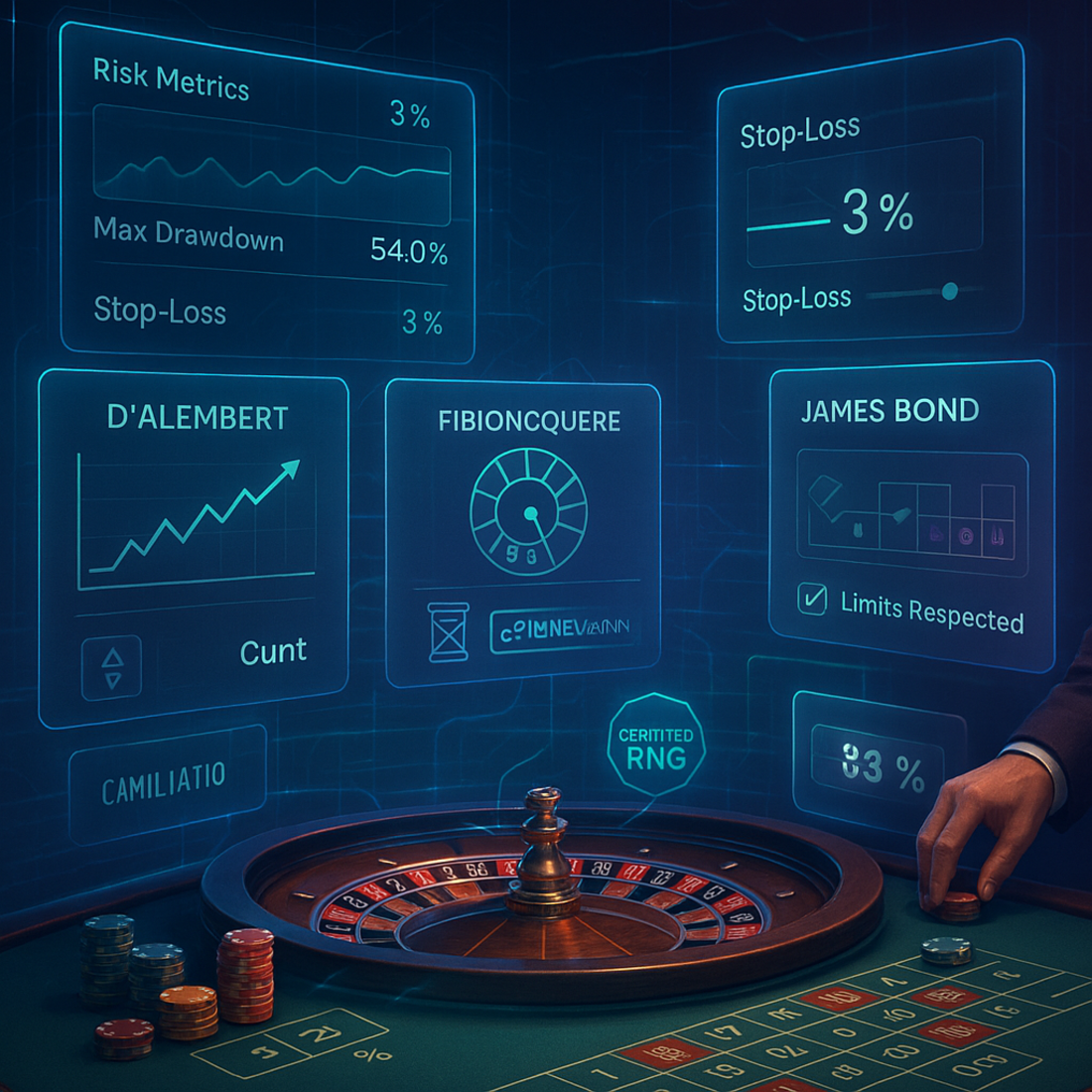
Recap of basic strategies
To build a foundation for more complex play it’s essential to understand roulette’s core systems. These methods offer a structured way to approach each spin and set the stage for strategic betting. Martingale, Reverse Martingale, and flat-bet systems also guide wager sizing & risk control. They show how to balance potential gains against bankroll limits. These tools form the basis for smart decisions. For greater adaptability and confidence, you will later explore advanced techniques.
Martingale and reverse Martingale
Martingale — after each loss, double the bet so that the first win covers all previous losses and brings a profit equal to the initial bet. Example: you bet USD 1 on “black” and lose, then bet USD 2 (loss), then USD 4 and win. Total investment — USD 1 + USD 2 + USD 4 = USD 7, the win on a bet of USD 4 with a payout of 1:1 is USD 8, net profit is USD 1. Reverse Martingale (Paroli): after each win, double the bet to “catch up” with a winning streak, and after a loss (or reaching a predetermined profit), return to the starting amount. Example: you start with USD 1 and win (+USD 1), then bet USD 2 and win again (+USD 2). In the third step, you bet USD 4, but lose (−USD 4). The result of the cycle is: +USD 1 + USD 2 − USD 4 = −USD 1. If the third move had also been a win, the net profit would have been USD 1 + USD 2 + USD 4 = USD 7, and then you would have locked in the win without risking it.
Flat betting system
Simple and reliable: the player bets the same amount regardless of the outcome. This helps control losses and makes the strategy predictable.
This system reduces emotional pressure, since losses do not grow exponentially. It is especially useful in a long gaming session, where it is important to maintain stability and avoid financial overheating.
Key takeaways for beginners
Strategy is important, but it does not replace an understanding of probabilities. Beginners are advised to choose European roulette, avoid aggressive catch-ups, and always set limits. It is important to remember that no strategy guarantees a win – roulette always remains a game with a negative mathematical expectation. However, a reasonable approach, discipline, and knowledge of the basics will help you get more control and enjoyment from the game.
Advanced roulette strategies
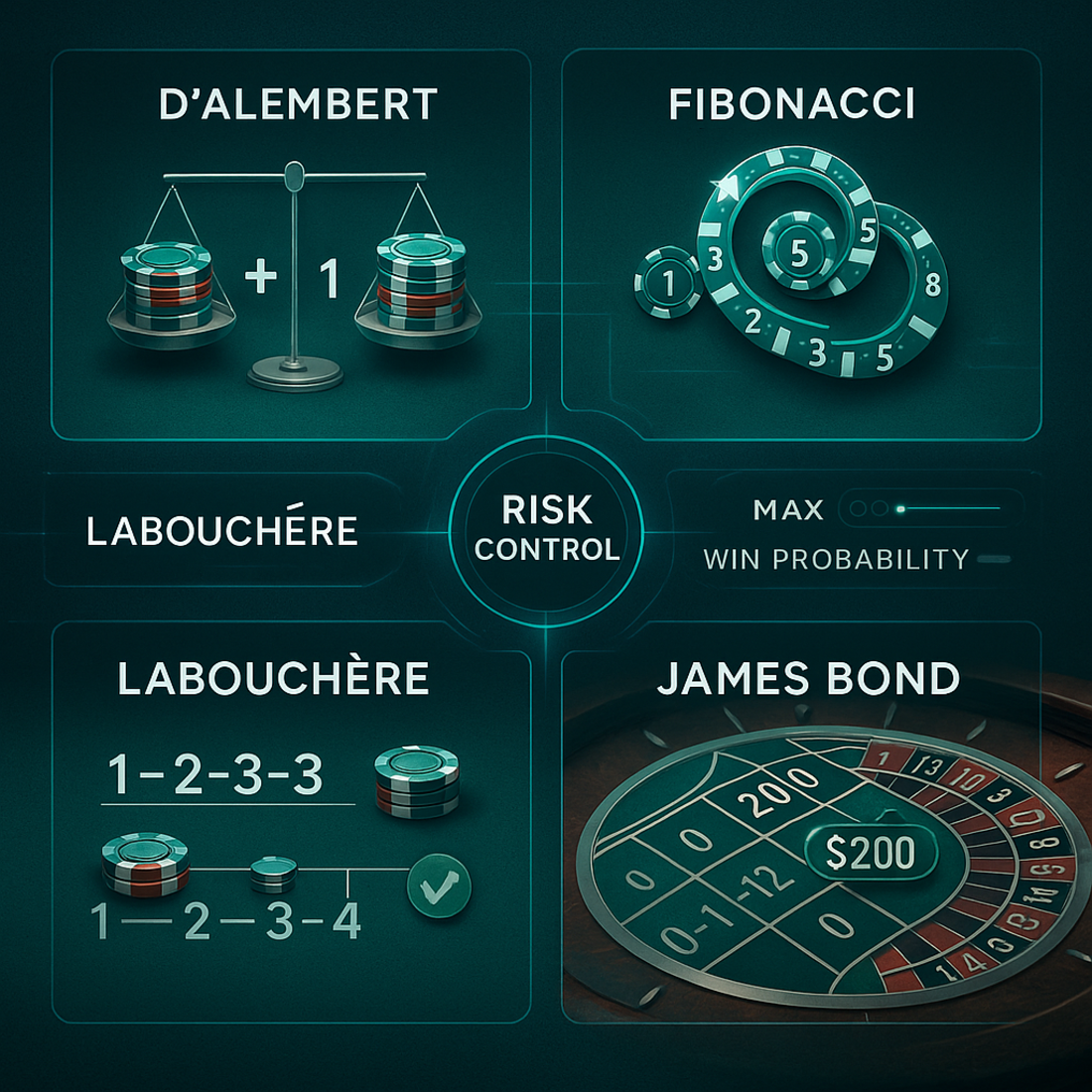
Roulette strategy p.2 explores what comes next after the basics. Once the basic approaches are mastered, players begin to look for more flexible and balanced betting systems. Advanced roulette strategies do not promise a guaranteed win, but they help to better manage risk, especially over the long term. Below is an analysis of four popular methods.
D’Alembert system
The D’Alembert system is based on the principle of gradually increasing the bet after a loss and decreasing it after a win. Unlike Martingale, where the bets double, here the player adds only one unit after a loss and subtracts one after a win. This method is more gentle on the bankroll and gives a sense of control over the situation. However, with a long series of losses, the strategy also does not save from the accumulation of losses.
Fibonacci betting system
Fibonacci uses a sequence of numbers, where each next one is the sum of the two previous ones (1, 1, 2, 3, 5, 8, etc.). When losing, the bet increases according to this sequence, when winning, it goes back two steps. This approach helps to “smear” losses over a long distance. The strategy looks balanced, but requires careful monitoring of the sequence and patience.
Labouchère (cancellation system)
Labouchere is a strategy where the player sets the desired profit, for example: 1-2-3. The bet is the sum of the first and last numbers (1+3=4). When winning, these numbers are crossed out, when losing, the sum is added to the end of the row. The system allows for flexible game planning, but can lead to a high bet size if the losing streak drags on. It works well with short streaks, but requires strict accounting and discipline.
James Bond strategy
This system involves a fixed amount (e.g. USD 200) spread across the board: USD 140 on high numbers (19-36), USD 50 on six numbers (13-18), and USD 10 on zero. The strategy covers a large part of the board and often leads to short-term winnings. However, if a number from 1 to 12 comes up, the entire bet is lost. It is a stylish but risky method that is more suitable for short sessions and entertainment.
Comparing strategy effectiveness
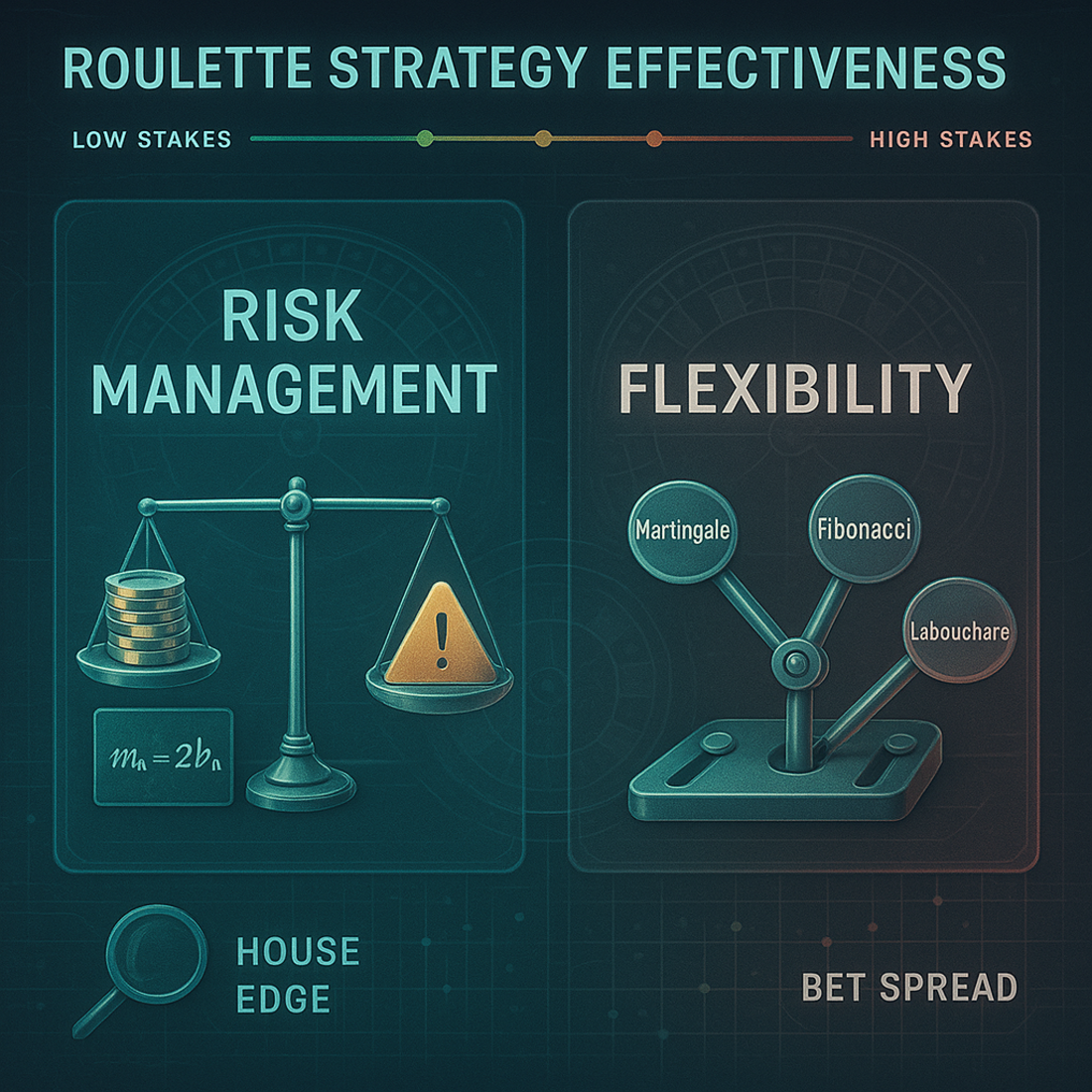
Each roulette strategy has its pros and cons. The effectiveness of a system depends on how it handles risk, how flexible it is, and the conditions under which it is used. Below we will consider the key aspects of strategy evaluation.
Win potential vs. risk exposure
Aggressive strategies like Martingale or Labouchere can quickly bring profits with short successful sessions. But with each loss, the stakes increase, and the risk quickly becomes uncontrollable. More conservative approaches, such as fixed bets or the Fibonacci system, limit losses, but do not allow you to quickly increase your profit. Therefore, it is important to understand: the higher the potential win, the higher the level of risk. A successful player chooses a strategy not by the size of the payout, but by the ability to manage risks.
Strategy performance in different roulette variants
Strategies work differently depending on the type of roulette. For example, the European version with one “zero” gives a better chance of success for most systems, especially if it uses the “La Partage” or “En Prison” rules. American roulette with two “zeros” reduces the effectiveness of strategies due to the higher house edge. Some methods, like the James Bond strategy, become especially vulnerable in this version of the game.
How to adjust based on table limits
Table limits are an important factor that is often ignored by players. For example, the Martingale strategy requires increasing bets, but with several losses in a row, you can run into the maximum set by the casino. Before starting the game, it is worth studying the minimum and maximum bets on the selected table and calculating in advance how many steps the strategy will “hold out” until it stops. For advanced systems, it is advisable to choose tables with a high ceiling and a suitable bank limit.
Managing risk like a pro

Understanding strategies is only half the battle. True control comes from managing your bets, emotions, and expectations. Here are three professional principles that will help you preserve your bankroll and not get out of control.
Stop-loss and win goals
Before starting a session, you need to define two key limits: stop-loss — the maximum amount you are willing to lose, and the winning target — the amount at which you end the game. This helps to avoid a situation where a player, being in the minus, tries to win back, or, conversely, wins, but continues to bet and loses everything. Clear financial limits protect against impulsive decisions and make the game more conscious.
Avoiding the gambler’s fallacy
The gambler’s fallacy is the false belief that a series of reds will always result in a black. In reality, each spin is an independent event, and the roulette wheel has no “memory”. Trying to guess the outcome based on past results is a path to irrational betting. A professional approach requires a complete rejection of superstitions and belief in “symbolic” sequences.
Emotional discipline and tilt control
Tilt is a state where emotions start to control the game: anger, greed, irritation. In this state, the player loses concentration, ignores strategy and risks more than planned. To avoid tilt, it is important to take breaks, not play tired or irritated, and strictly follow a pre-established plan. Emotional stability is one of the main signs of a mature player.
Tools and resources to support strategy use
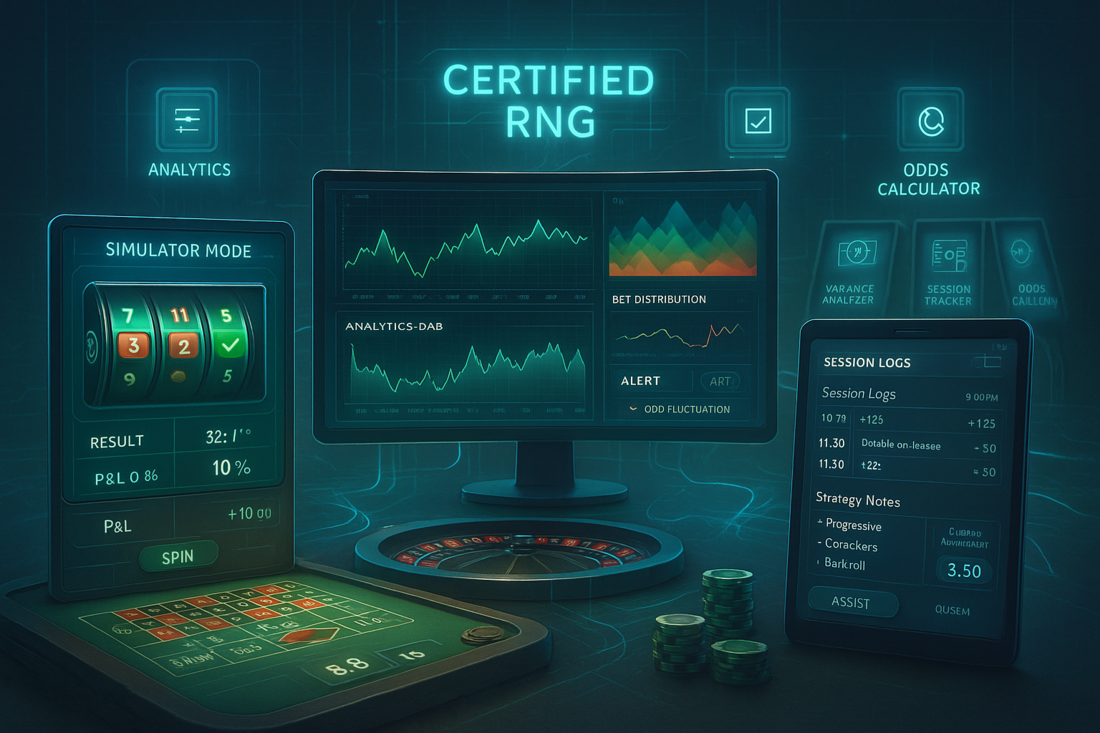
Even the most thoughtful strategy will not be effective without practice, analysis and the right gaming environment. Below is an overview of tools that will help a player test approaches, track their actions and adapt to the conditions of a particular casino.
Roulette simulators and practice apps
Simulators are a great way to try out strategies without the risk of losses. Online roulettes, mobile apps, and special simulators allow you to simulate real gaming sessions with betting settings, rules, and limits. This practice helps you understand the behavior of strategies over time, identify weaknesses, and develop the habit of sticking to a plan. Simulators that show graphs and statistics on winnings and bankroll are especially useful.
Tracking sheets and bet logs
For advanced play, it is important not only to bet, but to record what and how you bet. Keeping a betting log helps to identify errors, overestimations and inclination points. You can use Excel tables, Google Sheets or applications with ready-made templates. Regular analysis of your own data allows you to adjust your strategy, better understand your game dynamics and make more informed decisions in the future.
Casino features that help or hurt strategy use
Some casinos provide tools that make the game easier: history of the drops, the ability to repeat the bet, autoplay with specified parameters. All this is useful for strategic play. However, there are also limitations: table limits, minimum bets, timers between rounds. All this can prevent you from implementing the chosen system, especially if it requires flexibility. Therefore, it is important to study the rules of a particular casino in advance and select those conditions that suit your strategy.
Common mistakes with advanced strategies
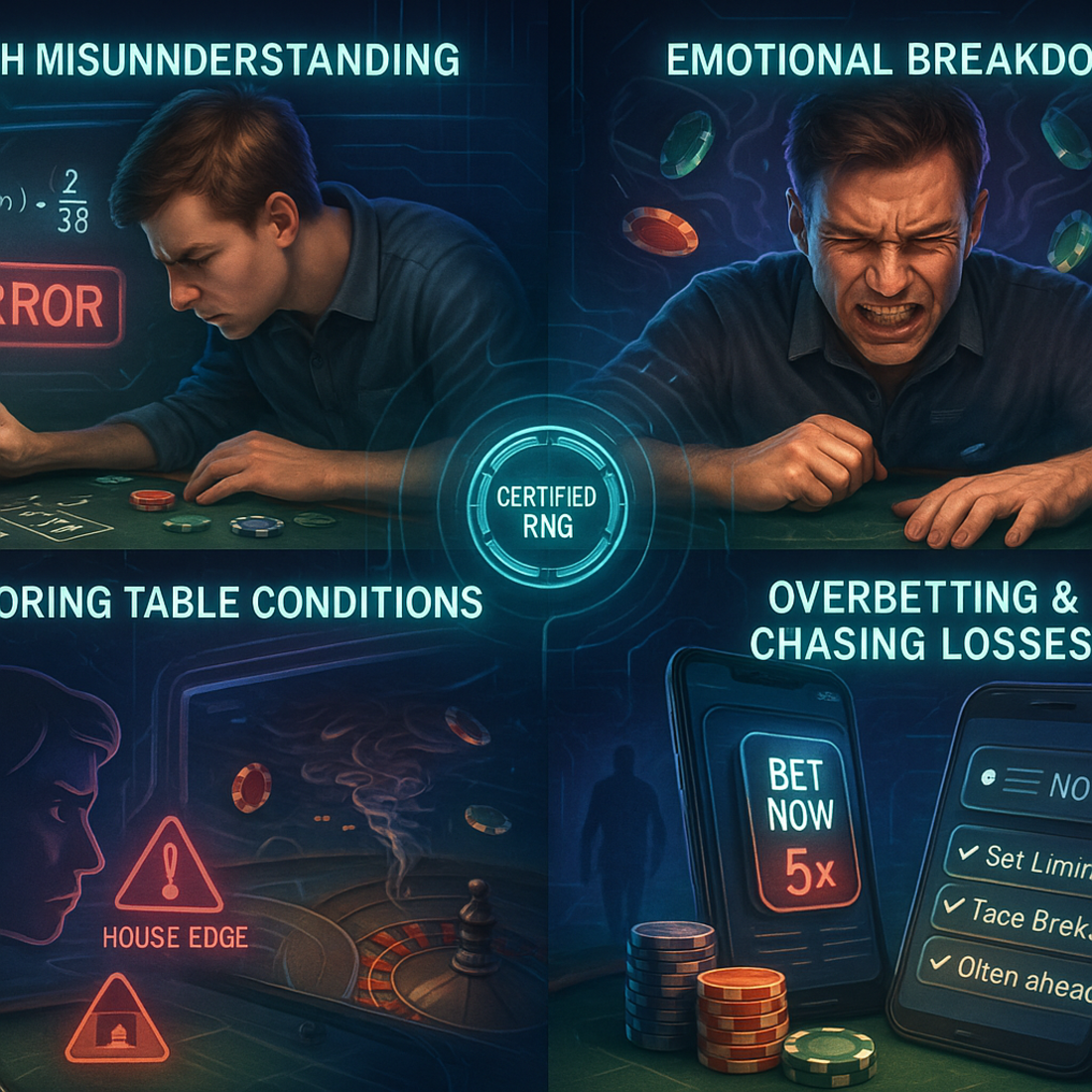
Advanced strategies offer more flexibility and control, but that doesn’t make them infallible. Misunderstandings of math, emotional breakdowns, and misinterpretations of the game environment can quickly throw a strategic approach into disarray. Let’s look at the most common problems.
Misunderstanding probability
One of the key mistakes is believing that strategy “changes the odds.” But the probability of each number in roulette remains constant, regardless of previous results. Players often overestimate the complexity of systems and forget that even an advanced strategy does not cancel out the built-in casino advantage. To play consciously, you need to understand the mathematics of betting and accept its limitations.
Chasing losses
After a series of losses, it is easy to fall into the trap of “catch-up” – the desire to win back at any cost. This is especially dangerous in systems with increasing stakes, where you can quickly go beyond the table limits and lose the entire bank. Chasing losses is an emotional, not a strategic decision. The player loses control, disrupts the plan and jeopardizes the entire game.
Ignoring table dynamics
Each casino and gaming table has its own specifics: limits, game pace, availability of functions and even the behavior of other players. Ignoring these factors reduces the effectiveness of even the most logical strategy. It is important to be able to adapt: change the bet size, take breaks, choose the right table. Advanced play is not only following the system, but also the ability to respond to the context.
Mastering advanced techniques from roulette strategy p.2 gives you more control, structure, and long-term awareness at the table. While no system can eliminate risk entirely, combining smart strategies with discipline, emotional control, and practical tools increases your chances of consistent, responsible play. The real strength lies in knowing when to bet, when to stop, and how to think like a strategist.

